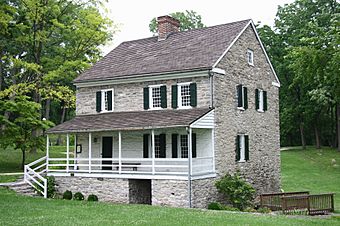Hager House (Hagerstown, Maryland) facts for kids
Quick facts for kids |
|
|
Hager House
|
|
 |
|
| Location | Hagerstown, Maryland |
|---|---|
| Area | 2 acres (0.81 ha) |
| Built | c. 1740 |
| Built by | Hager, Jonathan |
| NRHP reference No. | 74000974 |
| Added to NRHP | November 5, 1974 |
The Hager House is a cool old stone house in Hagerstown, Maryland, United States. It was built around 1740. The house was constructed by Jonathan Hager, a German immigrant from Westphalia. He was the person who founded Hagerstown!
This house is special because its basement has two pools of water. These pools are fed by natural springs, giving the house a secure water source. Jonathan Hager sold the property, which he called Hager's Fancy, to Jacob Rohrer. The house stayed in the Rohrer family until 1944. Then, the Washington County Historical Society bought it.
The restored house was given to the City of Hagerstown in 1954. It opened to the public in 1962 as a historic house museum. Today, the Hager House is located in Hagerstown City Park, off Key Street. You can visit it from April through December. Tours happen every hour from 10 AM to 4 PM. The Hager House also hosts many fun activities throughout the year. These include an annual Fall Fest, Doll House Tours, Ghost Tours, and Archaeological Dig-It Tours.
History of the Hager House
On June 5, 1739, Jonathan Hager bought 200 acres of land. This land was in the Great Appalachian Valley in Maryland. Today, this land is part of Hagerstown City Park and downtown Hagerstown. Hager built his stone house on top of two freshwater springs. He named his property "Hager's Fancy." The Hager House was added to the National Historic Registry in 1974. This means it is recognized as an important historical place.
How the Hager House Was Built
The Hager House is built in a German Colonial style. It has one chimney in the middle of the house. A central chimney helped keep the home warmer. Heat stayed inside instead of escaping through outside walls. In the summer, if the kitchen fireplace made too much heat, families used the Summer Kitchen. This kitchen was in the much cooler basement.
The house sits on top of two freshwater springs. These springs naturally stay at 40 degrees Fahrenheit all year. The springs helped control the room's temperature. They also provided drinking water. Plus, they kept food fresh, much like a modern refrigerator. Near the springs, the fireplace had many uses. It was used for cooking in the summer. The rest of the time, Hager likely used it for blacksmithing.
The basement walls are 17 inches thick stone. This offered great protection from attacks and bad weather. A large wall separates the springs from the other half of the basement. This wall has an embrasure, which is like an arrowslit in a medieval castle. It could be used to attack an intruder while keeping Hager safe. The other half of the basement was used to store animals. Animals were kept there in bad weather or during winter. This kept them safe. Their body heat also helped warm the home. The animals came in through a large Double Dutch Door. The top half of this door could be left open for light or fresh air.
To enter the basement without using the double Dutch door, there was once a trapdoor in the kitchen. Today, the Hager House has stairs that come from what used to be the pantry. The first floor of the house has four rooms. These are the kitchen, parlor, hall, and trading post. Upstairs, the hall leads to two rooms. A third room branches off the Master Bedroom. This room was often used for children or girls of the home. This way, they could be watched by their parents. Finally, another staircase leads to an attic. This attic was once used as a bedroom by people who rented parts of the home.
Outside the house, there used to be a barn. This barn was torn down during renovations on the property. Now, a museum stands in its place. It also has a small residence upstairs.
See also
 In Spanish: Casa Hager (Maryland) para niños
In Spanish: Casa Hager (Maryland) para niños




